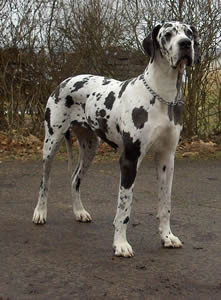
The Great Dane, Apollo, Danish Gallant, Deutsche Dogge, Boarhound, Grand Danois or German Mastiff is a breed of domestic dog (Canis lupus familiaris) known for its giant size. The breed is commonly referred to as the “Apollo of all breeds”. The Great Dane is one of the world’s tallest dog breeds. The current world record holder, measuring 109cm from paw to shoulder; 220cm from head to tail, is George. The previous Great Dane to hold the world record as tallest living dog was Gibson, who was 3+1⁄2 ft (106.7 cm) tall at the withers and 7 ft 1 in (215.9 cm) on his hind legs.
Appearance
As described by the American Kennel Club, “The Great Dane combines, in its regal appearance, dignity, strength and elegance with grand size and a well-formed body. One of the largest working breeds, it never appears ugly.”
The Great Dane is a short haired breed with a strong galloping figure. In the ratio between length and height, the Great Dane should be square. The male dog should not be less than 30 in (76 cm) at the shoulders, a female 28 in (71 cm). Danes under minimum height are disqualified.
From year to year, the tallest living dog is typically a Great Dane. Previous record holders include Gibson and Titan, however the currently record holder is a grey Great Dane named Giant George who stands 43 in (110 cm) at the shoulder. He is also the tallest dog on record (according Guinness World Records), beating the previous holder who was a brindle Great Dane named Shamgret Danzas, who stood 42.5 in (108 cm) at the shoulder.
The minimum weight for a Great Dane over eighteen months is 120 lb (54 kg) for males, 100 lb (45 kg) for females. Unusually, the American Kennel Club dropped the minimum weight requirement from its standard. The male should appear more massive throughout than the female, with a larger frame and heavier bone.
Great Danes have naturally floppy, triangular ears. In the past, when Great Danes were commonly used to hunt boars, cropping of the ears was performed to make injuries to the dogs’ ears less likely during hunts. Now that Danes are primarily companion animals, cropping is sometimes still done for traditional and cosmetic reasons. Today, the practice is somewhat common in the United States and much less common in Europe. In some European countries such as the United Kingdom, Ireland, Denmark, Germany, parts of Australia, and in New Zealand, the practice is banned, or controlled to only be performed by veterinary surgeons.
Coat colours
There are six show-acceptable coat colours for Great Danes:
Fawn: The colour is yellow gold with a black mask. Black should appear on the eye rims and eyebrows, and may appear on the ears.
Brindle: The colour is fawn and black in a chevron stripe pattern. Often also they are referred to as having a tiger-stripe pattern.
Blue: The colour is a pure steel blue. White markings at the chest and toes are not desirable and considered faults.
Black: The colour is a glossy black. White markings at the chest and toes are not desirable and considered faults.
Harlequin: The base colour is pure white with black torn patches irregularly and well distributed over the entire body; a pure white neck is preferred. The black patches should never be large enough to give the appearance of a blanket, nor so small as to give a stippled or dappled effect. Eligible, but less desirable, are a few small grey patches (this grey is consistent with a Merle marking) or a white base with single black hairs showing through, which tend to give a salt and pepper or dirty effect. (Have the same link to deafness and blindness as Merle and white danes.)
Mantle (in some countries referred to as Bostons due to the similar coloration and pattern as a Boston Terrier): The colour is black and white with a solid black blanket extending over the body; black skull with white muzzle; white blaze is optional; whole white collar preferred; a white chest; white on part or whole of forelegs and hind legs; white tipped black tail. A small white marking in the black blanket is acceptable, as is a break in the white collar.
Other colours occur occasionally but are not acceptable for conformation showing, and they are not pursued by breeders who intend to breed show dogs. These colours include white, fawnequin, merle, merlequin, fawn mantle, and others. Some breeders may attempt to charge more for puppies of these “rare” colours. However, the breeding of white and merle Danes is particularly controversial, as these colours may be associated with genes that produce deafness. Although they cannot be shown, white or merle Danes can usually still be registered as pedigree dogs.
Temperament
The Great Dane’s large and imposing appearance belies its friendly nature; the breed is often referred to as a gentle giant. Great Danes are generally well-disposed toward other dogs, other non-canine pets and humans. Some individuals may chase or attack small animals, but this is not typical of the breed.
—————————————————————————————————————–
CARING FOR YOUR DOG NEWSLETTER – Delivered Directly To Your Inbox – Starting Immediately – SIGN UP FOR FREE TODAY
—————————————————————————————————————–
